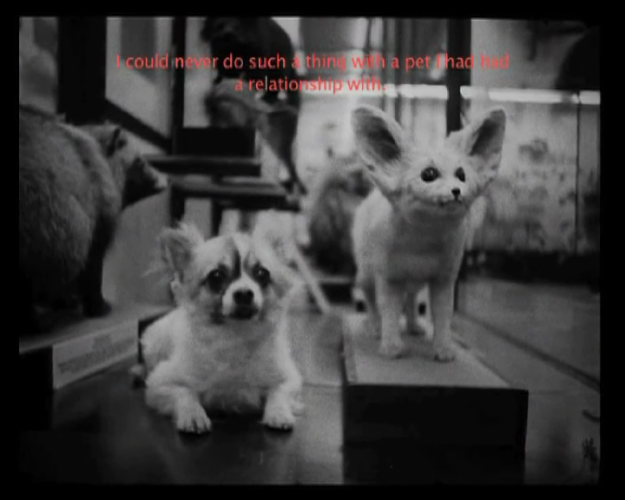Date: 04.04.2024 — 12.04.2024
Beginning: 19:00
Zoos are created mainly for people. If their primary interest were animals and their welfare, the aesthetic and practical values of zoos as exhibition spaces would probably be different, and perhaps there would be no zoos at all. Animals are in zoos to be seen. But the gazes between humans and animals are reciprocal. This series of videos explores these looks, their history and their future. The gazes carry not only curiosity or fear but also questions (and answers) about power, awareness of one’s subjectivity, the meaning of life, mutual difference and solidarity.

Noor Abuarafeh, Am I the Ageless Object at the Museum?, 2018, 14’59’’
Palestinian artist Noor Abuarafeh’s work explores the reconstruction of (colonial) history, memory, and the politics of archiving and neglected narratives. The film Am I the Ageless Object at the Museum? portrays animals of various sizes and “glories,” whether in an enclosure, a cage, or formaldehyde. The narrator’s voice contemplates memories, reciprocity, and a sense of self. But whose memories are these? And what kind of world – life – do they create? The animals we look at are not just symbols into which we project our imaginations and emotions; they represent the “nations” of the natural world, preserved objects without life. The film was shot in zoos in Palestine, Egypt and Switzerland in 2018. Most of the animals in the Gaza Zoo died as a consequence of Israeli military attacks by starvation or airstrikes by November 2023. In light of this horrifying war conflict, Noor Abuarafeh’s film raises questions of identity, national heritage and the right to self-determination with even greater urgency.

Hana Nováková, Eternal Life / Život věčný, 2009, 13’22’’
Czech documentary filmmaker, ethnozoology PhD scientist and Bengali interpreter Hana Nováková set her first film, Life Eternal, to the National Museum in Prague. In its showcases, as well as in the normally inaccessible taxidermy laboratory, she seeks answers to what happens to life after death, when the “sparks disappear from the eyes” and the animal becomes a specimen, an object, an “ambassador” representing the world of (living) animals. Her search leads her to the famous Felix the fennec, and even the mystery of František Palacký’s brain.
TW: The film uses footage from the taxidermy of a bird and a giant anteater.

Patrick Goddard, Animal Antics, 2021, 37’54’’
In the near future, Whoopsie the dog and her friend Sarah take us on a guided tour of the London Zoo in Patrick Goddard’s absurd comedy Animal Antics. On this tour, the pedigree dog explores the “wilderness” and searches for her relationship with the Other and their value, casually glossing insights from phenomenology, philosophy and post-humanism, or references to, for example, the first computer to pass the Turing test, or to fairytale Disney worlds and Donald Trump supporters.
curator: Sára Märc
lecture and essay: Hana Nováková
graphic design: Nela Klímová
translation and subtitles: Markéta Effenbergerová
production: Anna Davidová, Nela Klajbanová
pictures: Jan Kolský